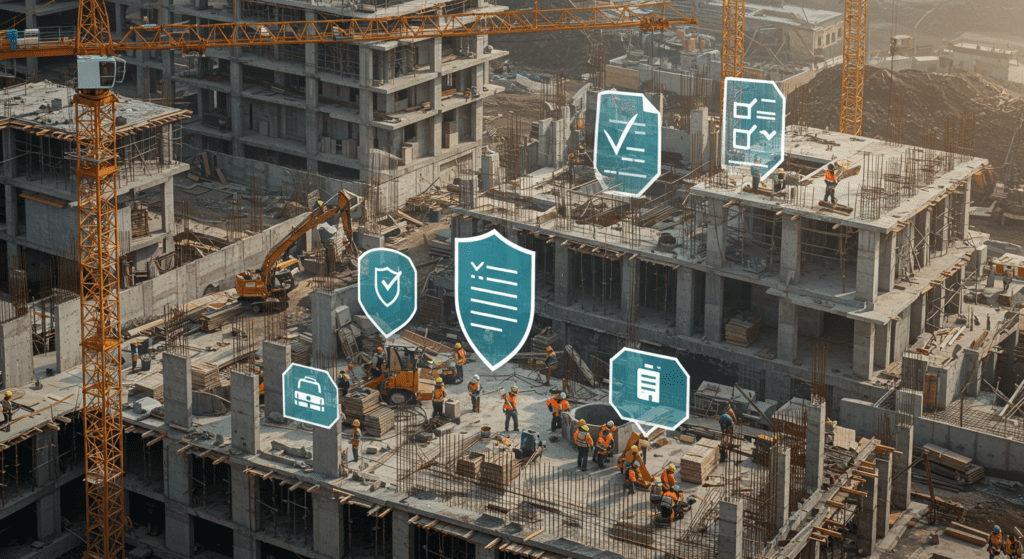- Importance of Insurance in Construction Projects
- Key Coverage Options Explained
- Assessing Policy Costs and Benefits
- Evaluating Insurer Reputation and Reliability
- Comparing Claims Process and Customer Service
- Understanding Regulatory Impacts
- Brokers vs. Direct Purchase Approaches
- Strategic Tips for Negotiating Rates
- Future Trends in Construction Insurance
Construction insurance provides essential protection for projects, contractors, and developers by mitigating risks associated with building sites. In an industry filled with complex variables—from weather uncertainties to on-site accidents—these policies act as a safety net. With coverage options tailored to the construction process, including material damage, equipment breakdown, and liability claims, insurance ensures that unexpected events do not derail progress or jeopardize financial stability.

1. Importance of Insurance in Construction Projects
The construction industry is inherently risky, and insurance plays a critical role in safeguarding investments. Without proper coverage, unforeseen incidents such as structural damage, bodily injury, or property loss could lead to debilitating financial consequences, legal disputes, and delays. By providing both financial security and accountability, construction insurance helps maintain project continuity even in the face of adversity. Moreover, insurance is often a requirement for project permits or funding, underscoring its essential role in the community’s broader regulatory framework.
2. Key Coverage Options Explained
A typical construction insurance policy comprises several key coverage options. First, builders’ risk insurance covers the project during construction, protecting against damages from fire, vandalism, or theft. Liability insurance is another critical component, protecting against claims arising from accidents encountered on the construction site. Additionally, workers’ compensation insurance addresses potential injuries sustained by employees, ensuring that health-related costs do not leave businesses vulnerable. Equipment and machinery insurance is also common; it protects expensive tools and machinery from damage or theft. Each type of coverage is designed to work collectively, providing a comprehensive shield against various risks inherent to construction.

3. Assessing Policy Costs and Benefits
Determining the appropriate insurance premium involves analyzing both costs and benefits. Premiums are influenced by factors such as project size, location, history of claims, and the complexity of construction activities. While a lower premium might seem appealing short-term, it is crucial to consider the extent of coverage and limits offered. Detailed assessments that factor in potential future repairs, delay costs, or litigation expenses can reveal that a slightly higher premium may ultimately provide greater peace of mind. Therefore, businesses need to balance costs with the level of coverage that aligns with their risk exposure and financial strategy, ensuring that they are prepared for any eventuality.
4. Evaluating Insurer Reputation and Reliability
A reliable insurer is a cornerstone for construction projects. When assessing potential insurance providers, contractors should look into the company’s longevity, client reviews, and claims settlement track record. Reputable insurers tend to have clear policies and are transparent regarding their processes. They also maintain strong financial health, demonstrating the capacity to cover substantial and unexpected claims. External ratings by independent agencies can serve as additional benchmarks. By prioritizing reputable companies, construction businesses ensure that, in the event of a claim, the process will be smooth and the insurer will honor commitments without delay.

5. Comparing Claims Process and Customer Service
The claims process is a vital component of construction insurance, as it greatly impacts recovery time and financial stability following an incident. A well-organized and responsive claims process can reduce downtime and restore operations more quickly. To evaluate this aspect, contractors should review historical data on claim turnaround times, clarity of communication during claims, and the level of support provided. Customer service, therefore, is not just a convenience—it is a critical part of the overall risk management strategy. Companies that offer dedicated claim handlers, 24/7 support, and robust online account management can provide added assurance that clients will be well-served when issues arise.
6. Understanding Regulatory Impacts
The regulatory landscape significantly influences construction insurance. Local and national governments often impose specific insurance requirements as a condition for operating on a construction site or obtaining permits. These regulations are designed to protect the public, employees, and investors by ensuring that adequate risk management strategies are in place. Understanding regulatory implications is essential for construction companies, as non-compliance can result in hefty fines, halted projects, or increased risk exposure. Staying abreast of evolving regulations, including changes in environmental standards or labor laws, helps businesses tailor their insurance policies to meet both legal obligations and practical needs.

7. Brokers vs. Direct Purchase Approaches
Insurance brokers provide an intermediary role between construction companies and insurers by leveraging their expertise and market knowledge. They can help identify policies that best match a project’s unique risk profile, while also negotiating better terms. Direct purchases, on the other hand, allow businesses to work directly with an insurer, potentially reducing costs by eliminating broker fees. However, direct purchases may come with less personalized service and limited access to comparative market insights. Ultimately, the decision between brokers and direct purchases should reflect the company’s complexity, risk assessment capability, and preference for specialist advice. Engaging a broker might offer broader coverage options and a more personalized service while a direct relationship could suit simpler projects with standardized requirements.
8. Strategic Tips for Negotiating Rates
Negotiating construction insurance rates requires a strategic approach that combines clear communication with thorough market research. Begin by compiling a detailed risk profile of the project and historical claims data, which will support your case for lower premiums. Engaging in comparative research with other insurers can yield competitive quotes, fostering an environment conducive to negotiation. Contractors should also consider bundling multiple coverage options with the same insurer to secure discounts. Demonstrating safety records, quality management protocols, and commitment to regulatory compliance can further justify reduced rates. By adopting a proactive stance and leveraging all available information, projects can achieve a balance between comprehensive coverage and cost efficiency.

9. Future Trends in Construction Insurance
The construction industry is evolving, and so too is the realm of insurance. Technological innovations like drones, artificial intelligence, and smart sensors are increasingly used to monitor construction sites and manage risks more effectively. These advances not only enhance safety but also enable insurers to develop more dynamic and responsive policies. Customized coverage options based on real-time data could soon become the norm, allowing businesses to pay premiums that more accurately reflect current risk levels. Additionally, environmental concerns are prompting insurers to consider eco-friendly practices and sustainability initiatives, integrating climate change risks into policy structures. As global markets become more interconnected and technology continues to advance, the insurance industry will likely develop innovative products that better serve the industry’s evolving needs.

Conclusion
In conclusion, construction insurance is a fundamental element in navigating the risks inherent in the building industry. By thoroughly examining coverage options, assessing policy costs against benefits, and evaluating both insurer reliability and the efficiency of claims processes, contractors can ensure that they are well-prepared to handle any unforeseen events. Remaining informed about regulatory shifts, understanding the pros and cons of broker versus direct purchase approaches, and being strategic during negotiations further solidifies a company’s risk management framework. As future trends continue to shape the industry landscape—with technology playing a more central role and environmental factors gaining prominence—the construction insurance sector is poised for transformative changes that promise enhanced protection and efficiency.
The process of selecting the right insurance is both strategic and multifaceted, requiring companies to keep a close eye on market dynamics and regulatory developments. In a field marked by inherent unpredictability, the importance of choosing an adaptable, reliable, and comprehensive insurance solution cannot be overstated. The evolving technologies present opportunities to gain greater insights into risks, while also providing a pathway to more customized and flexible policy offerings.
Contractors and developers looking to secure their projects must prioritize due diligence in every aspect of insurance selection. From assessing financial stability to understanding claims handling procedures and regulatory compliance, each step plays an essential role in building a robust framework that can withstand the challenges of modern construction activities. Ultimately, informed decisions about insurance procurement not only protect businesses but also contribute to a safer, more resilient construction landscape.
As the industry moves forward, both insurers and policyholders will need to adapt to the new realities of technological integration, environmental sustainability, and ever-increasing risk complexity. By embracing these changes and taking proactive measures today, construction companies can lay a solid foundation for future success, ensuring that each project is safeguarded against the myriad uncertainties that the industry presents.
